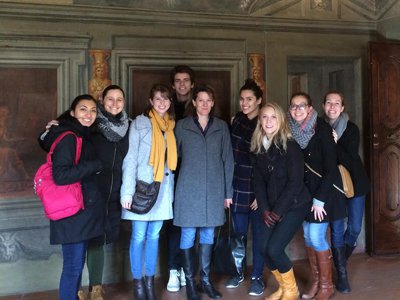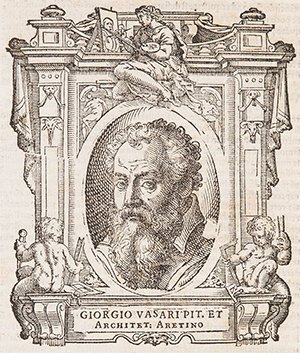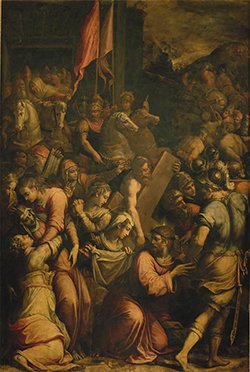Conference Honors 16th-Century Artist, Architect Giorgio Vasari
Professor Sally J. Cornelison G’89 among organizers, presenters

Sally J. Cornelison G’89, professor of art history and director of the Syracuse University Florence Graduate Program in Renaissance Art, co-organized a conference, to be held Thursday, March 3, and Friday, March 4, in Florence, Italy, to commemorate the 450th anniversary of Giorgio Vasari’s renovation of the basilica of Santa Croce. The Franciscan church dates from the thirteenth century, and is home to works by celebrated Renaissance artists, including the painters Giotto and Taddeo Gaddi and the sculptor Donatello. The church is also known as the burial site for the illustrious, including Michelangelo, Giacomo Rossini, Niccolò Machiavelli, and Galileo Galilei.

Vasari @ Santa Croce is sponsored by the Medici Archive Project, the Opera di Santa Croce, the Samuel H. Kress Foundation, and SU Florence. Cornelison, a specialist in the history of Italian late-medieval and renaissance religious art, will present a paper entitled “Vasari’s Last Tribute to Michelangelo: Content, Context, and the Buonarroti Altarpiece” during the conference.
Also organizing the conference was Paola Vojnovic G'06, international projects coordinator and head of public relations for the Church and Museum of Santa Croce. SU Florence will host a closing reception for conference participants and SU Florence art history faculty and graduate students.
Cornelison’s paper will be the basis of a chapter in her forthcoming book on Vasari’s religious paintings. In fall 2015, she taught a graduate seminar on Vasari’s renovation of Santa Croce. Students in that seminar who are now studying in Florence will attend the conference, where they will have an opportunity to meet an international cohort of Renaissance art experts.

The Italian painter, author, and architect Vasari (1511-1574) is best known for his “Lives of the Most Excellent Painters, Sculptors, and Architects.” Published in 1550 and 1568 in Florence, Vasari’s biographies of Renaissance artists are classics in the history of art and art criticism.
Most scholarly interest focuses on Vasari’s biographies of artists, says Cornelison, who is on sabbatical this semester. “He is a very important figure in the history of Western art,” she explains.
Vasari was the court artist to the House of the Medici, the wealthy and influential Florentine family whose support for the arts made Florence central to the cultural growth of the Renaissance. At the request of Medici Duke Cosimo I, Vasari undertook the renovation of the church in 1566.
“Vasari’s renovation of the church was a response to the Catholic Reformation,” Cornelison explains. “He removed the barrier that had separated the clergy from the laity since the later Middle Ages.” Vasari and his workshop also created new altars that line the walls of the church whose altarpieces tell the story of the Passion of Christ, the Christian story of Jesus Christ's arrest, crucifixion, and resurrection.

Cornelison’s talk will focus on an altarpiece depicting Christ Carrying the Cross that Michelangelo’s nephew commissioned from Vasari in 1568. Michelangelo, his father, nephew, and other relatives are buried in the chapel.
“Having one’s tomb within a church was a very desirable thing,” Cornelison explains. “It was believed that burial on consecrated ground could increase one’s chances for salvation.”
The narrative painting includes a portrait of Michelangelo that has never been noticed before. “I’m taking the first extensive, close look at this painting,” she explains. “Vasari was thinking carefully about the history and visual traditions of the church of Santa Croce and how the picture relates to the monument to Michelangelo located next to it.”
Cornelison hopes the conference will expand discussion of Vasari’s influence beyond his work as a writer. “His paintings are more interesting and important than they’ve been given credit for.”
Featured
Sally Cornelison Professor and Director, Florence Graduate Program in Italian Renaissance Art
